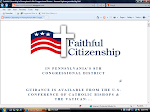- Chris Kahlenborn, MD (2001) maintained that "informed practicing Christian physicians will not give the 'post-rape pill' in any circumstances" <www.lifeissues.net/writers/kah/kah_03howpillworks2.html>.
- As per J. B. Shea, MD (2004), "Catholic hospitals are not free to prescribe or provide anything with abortifacient properties without contradicting their witness" <https://gmcmail.gmc.edu/exchweb/bin/redir.asp?URL=http://catholicinsight.com/online/bioethics/mornpill.shtml>.
The 9/27/07 Statement by Connecticut Bishops Regarding Plan B seemed to disregard the Vatican's 10/31/00 statement and the aforementioned warnings of the Catholic physicians: “Since the teaching authority of the Church has not definitively resolved this matter and since there is serious doubt about how Plan B pills work, the Catholic Bishops of Connecticut have stated that Catholic hospitals in the State may follow protocols that do not require an ovulation test in the treatment of victims of rape. A pregnancy test approved by the United States Food and Drug Administration suffices. If it becomes clear that Plan B pills would lead to an early chemical abortion in some instances, this matter would have to be reopened” <www.catholicculture.org/culture/library/view.cfm?recnum=7836> (Incredibly, the Food and Drug Administration itself readily acknowledged that "If fertilization does occur, Plan B may prevent a fertilized egg from attaching to the womb (implantation)").
On 11/1/07, the Catholic Medical Association (CMA) again weighed in: "scientific evidence supports the conclusion that all these formulations have some potential to prevent the implantation of a newly conceived human being....The crime of sexual assault should not be compounded by an action, the intent or direct effect of which causes the death of a human being in the first days of gestation" <www.cathmed.org/pressreleases/PlanB_and_CCC3.pdf>.
While it's difficult to understand how there could continue to be any question about the abortifacient potential of MAP/Plan B, the Vatican's 12/08 Dignitas Personae certainly should have put them to bed. MAP/Plan B would fall into a category called "interceptives" in Dignitas Personae. Such abortifacients are absolutely excluded by Dignitas Personae, as they have always been.
Caholics of Connecticut have not gained by what appears to have been acquiescence to government pressure. As per a statement by Bridgeport Bishop William Lori, "This past Thursday, the Judiciary Committee of the Connecticut State Legislature...introduced a bill that directly attacks the Roman Catholic Church and our Faith....It forces a radical reorganization of the legal, financial, and administrative structure of our parishes" <www.bridgeportdiocese.com/folder_bridgedocs/Dioc_Statement_on_Leg_1098%5B1%5D.pdf>.
Connecticut Catholics need our support. Yet, how on earth would the legislature get the idea that the Catholic Church in Connecticut was a push-over?


















.bmp)
.bmp)
.bmp)
.bmp)







